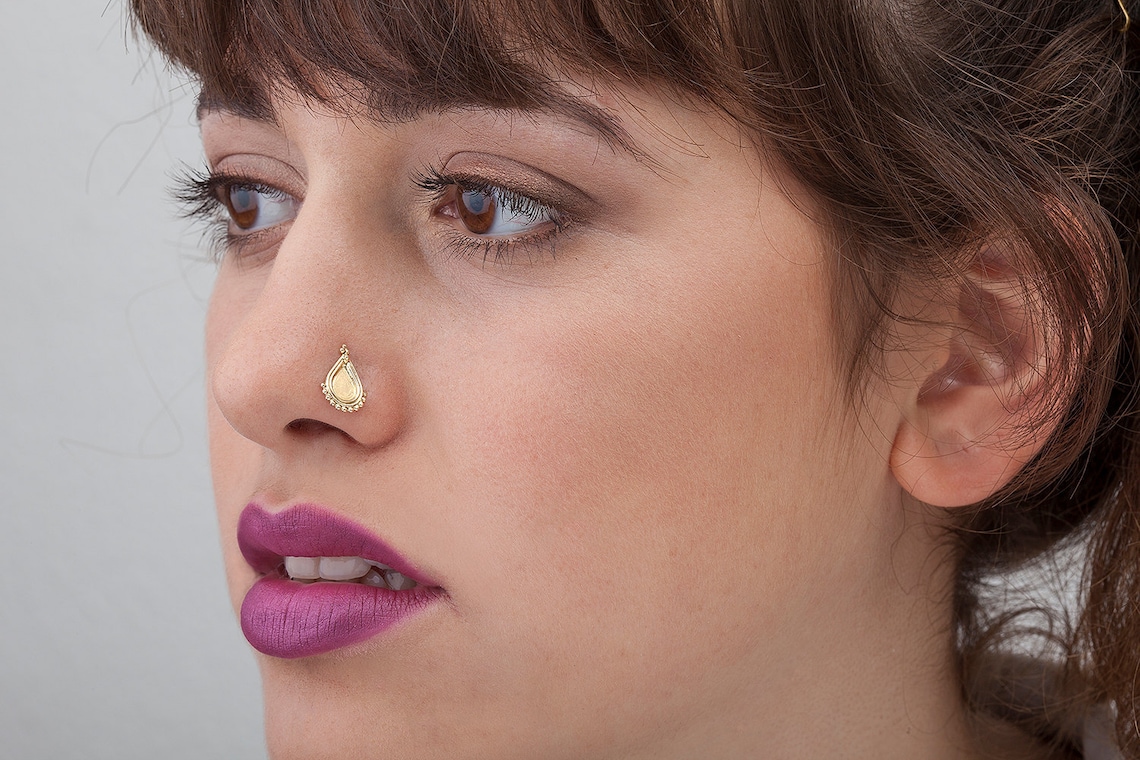
Nose piercing is a popular form of body modification that has been practiced for centuries in various cultures. It involves the puncturing of the skin or cartilage of the nose to insert jewelry.
If you’re considering getting a nose piercing, it’s important to be well-informed about the procedure, aftercare, and the types of jewelry available.
Nose Piercing Procedure
The process of getting a nose piercing involves several steps to ensure a safe and successful outcome. Here’s a brief overview of what you can expect during the procedure:
- Preparation: The piercer will sanitize their hands, wear gloves, and clean the area around your nose with an antiseptic solution.
- Marking: Using a surgical pen, the piercer will mark the exact spot where the piercing will be placed. This step allows you to review and approve the placement before the needle is inserted.
- Piercing: A sterile hollow needle or a piercing gun will be used to create the hole in your nose. The piercer will swiftly insert the jewelry immediately after making the hole.
- Aftercare instructions: The piercer will provide you with detailed aftercare instructions, including how to clean your piercing, what products to use, and how to avoid potential complications.
It’s crucial to choose a professional and reputable piercer who follows strict hygiene practices to minimize the risk of infections or complications.
Metals To Avoid For First Body Piercings
When it comes to choosing jewelry for your newly pierced nose, it’s essential to select metals that are safe and hypoallergenic. Certain metals can cause allergic reactions or infections, especially in fresh piercings. Avoid using the following metals for your initial nose piercing:
- Nickel: Nickel is a common allergen and can cause skin irritations and allergic reactions. It’s best to steer clear of jewelry containing nickel, as it can delay the healing process and lead to complications.
- Brass: While brass may have an attractive appearance, it often contains traces of nickel and can cause skin reactions.
- Sterling silver: Despite its popularity, sterling silver can tarnish easily and may contain other metals that can irritate the skin. It’s not recommended for initial piercings.
- Plated metals: Avoid jewelry that is only coated or plated with a metal like gold or silver. Over time, the plating can wear off, exposing the base metal, which can cause skin problems.
The Best Metals For Nose Piercing
To ensure proper healing and minimize the risk of complications, it’s advisable to choose jewelry made from safe and hypoallergenic metals. The following metals are considered suitable for nose piercings:
- Surgical stainless steel: This metal is commonly used in body piercing jewelry due to its hypoallergenic properties. It’s durable, affordable, and readily available in various designs.
- Titanium: Highly biocompatible and lightweight, titanium is an excellent choice for nose piercings. It’s often recommended for individuals with metal allergies or sensitive skin.
- Niobium: Similar to titanium, niobium is another hypoallergenic metal that is suitable for fresh piercings. It’s often used in medical implants due to its biocompatibility.
- 14k or 18k gold: Pure gold (24k) is too soft for body jewelry, but 14k or 18k gold alloys are considered safe for nose piercings. Choose yellow, white, or rose gold based on your preference.
It’s important to note that everyone’s body reacts differently, so what works for one person may not work for another. If you have a history of metal allergies, consult with a professional piercer to determine the best metal for your nose piercing.
Nose Piercing Jewelry
After getting your nose pierced, you’ll have a variety of jewelry options to choose from. The type of jewelry you select depends on personal style, comfort, and the healing stage of your piercing. Here are some common types of nose piercing jewelry:
- Nose bone: A nose bone is a straight post with a small bead or decoration on one end and a small ball or rounded end on the other. It’s easy to insert and secure, making it suitable for fresh piercings.
- Nose stud: A nose stud is a straight post with a decorative top that sits flat against the nostril. It’s a popular choice for its simplicity and versatility.
- Nose screw: A nose screw is similar to a nose stud, but it has a twisted or curved post that helps secure the jewelry in place.
- Nose ring or hoop: Nose rings come in various sizes and shapes, from small hoops to larger, more decorative rings. They can be worn through the piercing or as a septum piercing.
When choosing nose piercing jewelry, consider the material, size, and design. It’s best to start with a simple and lightweight option that won’t put excessive pressure on the healing piercing.
Nose Bone And Studs
Nose bones and studs are two common types of nose piercing jewelry. Here’s a closer look at each:
- Nose bone: Nose bones have a straight post with a small decorative end and a larger ball or rounded end that prevents the jewelry from slipping out. They are easy to insert and remove, making them suitable for beginners or those with less dexterity. However, nose bones can be challenging to clean thoroughly and may cause discomfort if they move or rotate inside the piercing.
- Nose stud: Nose studs have a straight post with a decorative top that sits flat against the nostril. They are simple, elegant, and versatile, making them a popular choice for nose piercings. Nose studs are relatively easy to clean and maintain, and they offer a comfortable fit for most individuals.
When choosing between nose bones and studs, consider factors such as your comfort level, ease of cleaning, and the specific look you want to achieve. It’s advisable to consult with your piercer for personalized recommendations based on your nose anatomy and lifestyle.
Nose Rings And Hoops
Nose rings and hoops are another popular option for nose piercings, adding a unique and stylish touch to your appearance. Here’s what you should know about them:
- Nose rings: Nose rings come in various sizes, shapes, and designs, ranging from small and subtle to large and ornate. They can be circular, semi-circular, or have decorative ends. Nose rings are versatile and allow you to express your personal style. However, keep in mind that some larger or heavier rings may require additional healing time.
- Nose hoops: Nose hoops are circular jewelry that encircle the nostril. They can be continuous or have a small gap for easy insertion and removal. Nose hoops come in different diameters, allowing you to choose a size that suits your preference. It’s important to ensure that the hoop is securely closed to prevent it from getting caught or snagged on clothing or objects.
Nose rings and hoops offer a wide range of aesthetic possibilities. Consider your personal style, comfort, and the healing stage of your piercing when selecting these types of jewelry.
How To Care For A Newly Pierced Nose?
Proper aftercare is crucial to ensure the healing process of your newly pierced nose goes smoothly. Here are some useful tips to care for your piercing:
- Cleanse the piercing: Use a saline solution or a gentle, fragrance-free soap recommended by your piercer to clean your piercing twice a day. Gently remove any crust or discharge around the jewelry and rinse thoroughly with water.
- Avoid touching or twisting the jewelry: It’s essential to resist the temptation to touch or twist your jewelry, as it can introduce bacteria and delay the healing process. Only handle the jewelry when necessary and always make sure your hands are clean.
- Be mindful of the healing time: Nose piercings typically take several weeks to several months to heal completely. During this time, avoid changing or removing the jewelry, except for cleaning purposes. Removing the jewelry too soon can cause the hole to close and lead to complications.
- Protect your piercing: Be cautious when getting dressed or combing your hair to prevent the jewelry from getting caught or pulled. Avoid sleeping on the pierced side and be mindful of activities that may put pressure on or irritate the piercing.
- Avoid swimming or soaking in water: Stay away from swimming pools, hot tubs, lakes, and other bodies of water during the healing period. These environments can introduce bacteria and increase the risk of infection.
- Avoid makeup and harsh chemicals: Avoid applying makeup, creams, or lotions directly on the piercing area, as they can clog the piercing and hinder the healing process. Additionally, avoid using harsh chemicals such as hydrogen peroxide or alcohol for cleaning, as they can be too drying or irritating.
Remember, every individual’s healing process may vary, so it’s essential to follow the aftercare instructions provided by your piercer and consult them if you have any concerns or questions.
Things You Should Avoid Doing
While caring for your newly pierced nose, there are certain activities and habits you should avoid to prevent complications and promote proper healing. Here are some things to steer clear of:
- Touching the piercing with dirty hands: Always make sure your hands are clean before touching or cleaning your piercing. Dirty hands can introduce bacteria and increase the risk of infection.
- Changing or removing the jewelry too soon: Leave the initial jewelry in place until your piercing has fully healed. Prematurely changing or removing the jewelry can lead to irritation or closure of the piercing.
- Using alcohol or hydrogen peroxide for cleaning: Avoid using harsh chemicals such as alcohol or hydrogen peroxide for cleaning your piercing. These substances can be drying and irritating, slowing down the healing process.
- Sleeping on the pierced side: Sleeping on the side of your newly pierced nose can cause discomfort, irritation, and even slow down the healing process. Try to sleep on your back or the opposite side during the healing period.
- Exposing the piercing to dirty water: Avoid swimming or soaking in bodies of water, such as pools, hot tubs, or natural bodies of water, during the healing period. These environments can introduce bacteria and increase the risk of infection.
- Playing with or twisting the jewelry: It’s crucial to avoid playing with or twisting the jewelry in your piercing. Excessive movement can irritate the piercing and prolong the healing process.
By avoiding these actions and following proper aftercare, you can help ensure a successful healing process and enjoy your new nose piercing.








